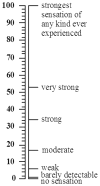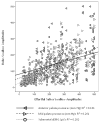Influence of the perceived taste intensity of chemesthetic stimuli on swallowing parameters given age and genetic taste differences in healthy adult women
- PMID: 24687466
- PMCID: PMC4318239
- DOI: 10.1044/1092-4388(2013/13-0005)
Influence of the perceived taste intensity of chemesthetic stimuli on swallowing parameters given age and genetic taste differences in healthy adult women
Abstract
Purpose: This study examined whether the perceived taste intensity of liquids with chemesthetic properties influenced lingua-palatal pressures and submental surface electromyography (sEMG) in swallowing, compared with water.
Method: Swallowing was studied in 80 healthy women, stratified by age group and genetic taste status. General Labeled Magnitude Scale ratings of taste intensity were collected for deionized water; carbonated water; 2.7% w/v citric acid; and diluted ethanol. These stimuli were swallowed, with measurement of tongue-palate pressures and submental sEMG. Path analysis differentiated stimulus, genetic taste status, age, and perceived taste intensity effects on swallowing. Signal amplitude during effortful saliva swallowing served as a covariate representing participant strength.
Results: Significant differences (p < .05) in taste intensity were seen across liquids: citric acid > ethanol > carbonated water > water. Supertasters perceived greater taste intensity than did nontasters. Lingua-palatal pressure and sEMG amplitudes were correlated with the strength covariate. Anterior palate pressures and sEMG amplitudes were significantly higher for the citric acid stimulus. Perceived taste intensity was a significant mediator of stimulus differences.
Conclusion: These data provide confirmatory evidence that high-intensity sour stimuli do influence swallowing behaviors. In addition, taste genetics influence the perception of taste intensity for stimuli with chemesthetic properties, which modulates behavioral responses.
Figures






Similar articles
-
Barium versus nonbarium stimuli: differences in taste intensity, chemesthesis, and swallowing behavior in healthy adult women.J Speech Lang Hear Res. 2014 Jun 1;57(3):758-67. doi: 10.1044/2013_JSLHR-S-13-0136. J Speech Lang Hear Res. 2014. PMID: 24167232
-
Differences in swallowing between high and low concentration taste stimuli.Biomed Res Int. 2014;2014:813084. doi: 10.1155/2014/813084. Epub 2014 Apr 30. Biomed Res Int. 2014. PMID: 24877135 Free PMC article.
-
Effects of chemesthetic stimuli, age, and genetic taste groups on swallowing apnea duration.Otolaryngol Head Neck Surg. 2011 Oct;145(4):618-22. doi: 10.1177/0194599811407280. Epub 2011 Apr 26. Otolaryngol Head Neck Surg. 2011. PMID: 21521895 Clinical Trial.
-
The effect of barium on perceptions of taste intensity and palatability.Dysphagia. 2014 Feb;29(1):96-108. doi: 10.1007/s00455-013-9487-4. Epub 2013 Sep 14. Dysphagia. 2014. PMID: 24037100 Free PMC article.
-
The Effect of Genetic Taste Status on Swallowing: A Literature Review.Am J Speech Lang Pathol. 2023 Jul 10;32(4):1770-1781. doi: 10.1044/2023_AJSLP-22-00384. Epub 2023 May 31. Am J Speech Lang Pathol. 2023. PMID: 37257285 Review.
Cited by
-
Orosensory contributions to dysphagia: a link between perception of sweet and sour taste and pharyngeal delay time.Physiol Rep. 2016 Jun;4(11):e12752. doi: 10.14814/phy2.12752. Physiol Rep. 2016. PMID: 27302989 Free PMC article.
-
History of the Use and Impact of Compensatory Strategies in Management of Swallowing Disorders.Dysphagia. 2017 Feb;32(1):3-10. doi: 10.1007/s00455-016-9779-6. Epub 2017 Jan 28. Dysphagia. 2017. PMID: 28130600 Review. No abstract available.
-
Targeting Chemosensory Ion Channels in Peripheral Swallowing-Related Regions for the Management of Oropharyngeal Dysphagia.Int J Mol Sci. 2020 Aug 27;21(17):6214. doi: 10.3390/ijms21176214. Int J Mol Sci. 2020. PMID: 32867366 Free PMC article. Review.
-
Taste Perception and Water Swallow Screen Results in Old-Old Women.Geriatrics (Basel). 2018 Nov 20;3(4):83. doi: 10.3390/geriatrics3040083. Geriatrics (Basel). 2018. PMID: 31011118 Free PMC article.
-
Effects of Food and Liquid Properties on Swallowing Physiology and Function in Adults.Dysphagia. 2023 Jun;38(3):785-817. doi: 10.1007/s00455-022-10525-2. Epub 2022 Oct 20. Dysphagia. 2023. PMID: 36266521 Review.
References
-
- Bartoshuk LM. Genetic and pathological taste variation: what can we learn from animal models and human disease? Ciba Found Symp. 1993;179:251–262. - PubMed
-
- Bartoshuk LM. Comparing sensory experiences across individuals: Recent psychophysical advances illuminate genetic variation in taste perception. Chemical Senses. 2000;25(4):447–460. - PubMed
-
- Bartoshuk LM. Psychophysics: a journey from the laboratory to the clinic. Appetite. 2004;43(1):15–18. - PubMed
-
- Bartoshuk LM, Beauchamp GK. Chemical senses. Annu Rev Psychol. 1994;45:419–449. - PubMed
-
- Bartoshuk LM, Duffy VB, Green BG, Hoffman HJ, Ko CW, Lucchina LA, Weiffenbach JM. Valid across-group comparisons with labeled scales: The gLMS versus magnitude matching. Physiology and Behavior. 2004;82(1):109–114. - PubMed
Publication types
MeSH terms
Substances
Grants and funding
LinkOut - more resources
Full Text Sources
Other Literature Sources
Medical

